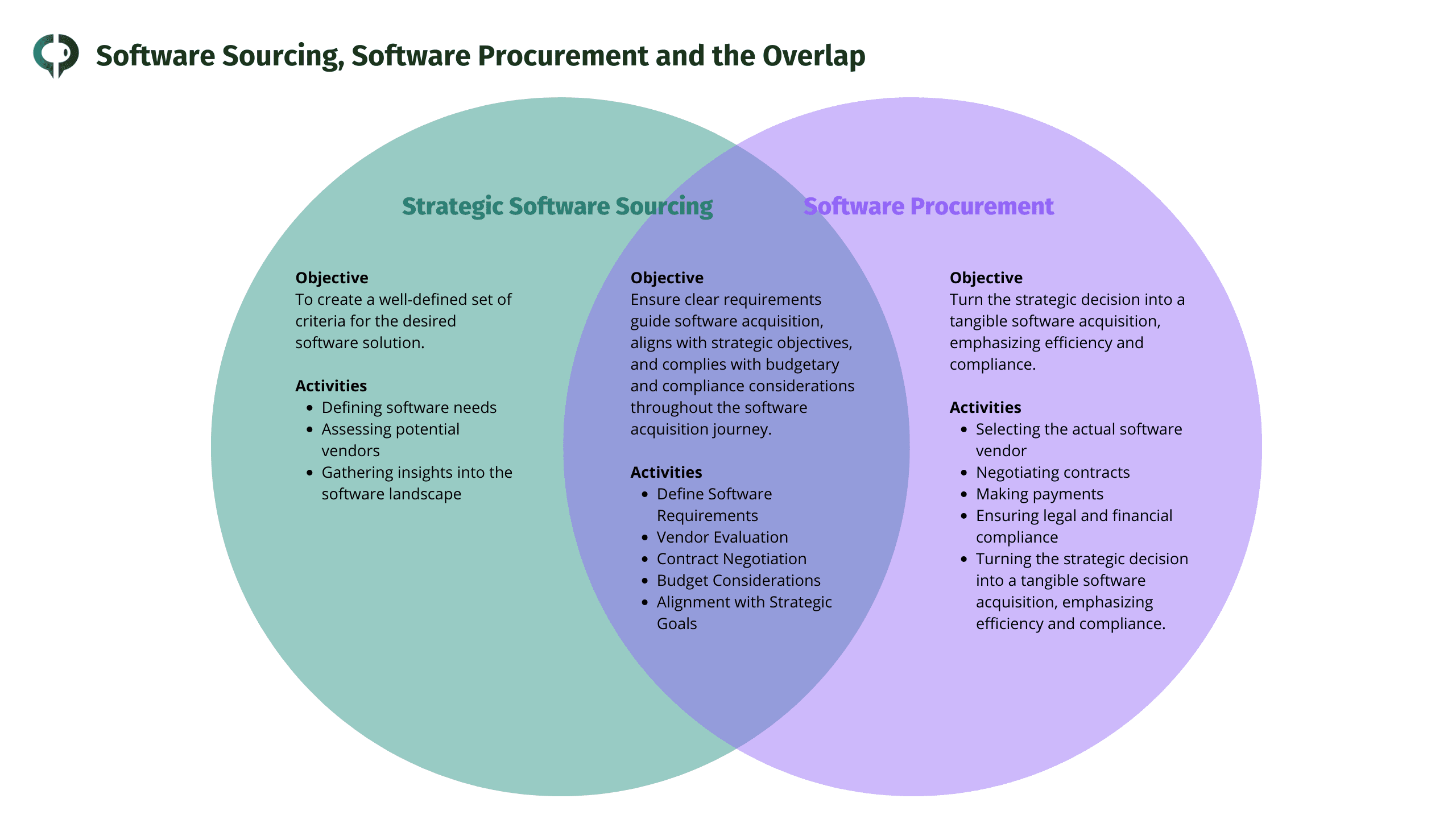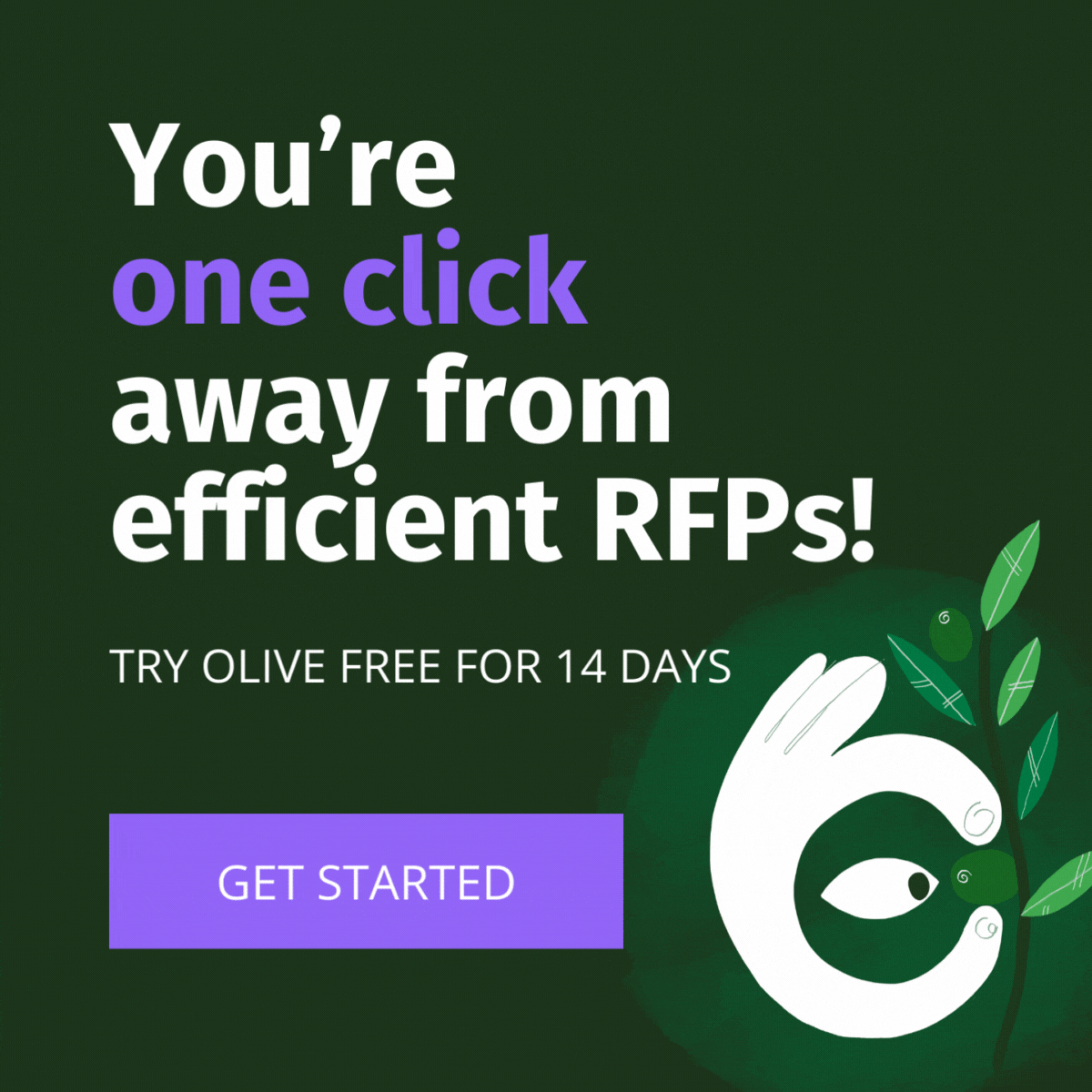Software Sourcing vs Software Procurement
What distinguishes sourcing from procurement? Explore how these distinct procedures collaborate to enhance vendor relationships, identify best-fit solutions, and maintain cost-effectiveness for long-term gains.
The world of software acquisition can be complex, with two critical facets often causing confusion: software sourcing and software procurement. We aim to clarify these activities in the context of software aquisition, emphasizing how they differ and, most importantly, how Olive can be the perfect solution for software sourcing in enterprises. Understanding the nuances of these processes is essential, as it lays the foundation for informed decision-making and successful software acquisitions.
Let’s establish a clear understanding of the distinctions between software sourcing and software procurement:
What is Software Sourcing?
In the enterprise context, software sourcing is the systematic process of identifying, evaluating, and selecting software solutions that align with an organization’s strategic objectives and operational requirements.
It encompasses defining software needs, evaluating potential vendors, budget considerations, legal and financial agreements, and vendor relationship management.
“Software sourcing is essential for enterprises to acquire software that enhances operational efficiency, supports business goals, and maintains budget constraints while ensuring that the selected solutions set the stage for successful software procurement.”
This initial step involves identifying and selecting the right software vendors for an organization’s specific needs. It includes researching potential vendors, evaluating offerings, and choosing the software that aligns with strategic goals and technical requirements.
What is Software Procurement?
Software Procurement encompasses the acquisition of the selected software solution, managing contracts, payments, and deployment planning. It focuses on the legal and financial aspects of software acquisition.
Why the Software Procurement Process Relies on Strategic Sourcing
From Olive’s perspective, the software procurement process relies on strategic sourcing as the linchpin for success. Strategic sourcing is paramount for cost optimization, negotiation prowess, risk mitigation, and efficiency.
By employing strategic sourcing, companies can streamline the procurement process, reducing costs related to SaaS software, improving negotiation leverage, and selecting known and trusted vendors to mitigate risks.
This collaboration is pivotal in reaping long-term gains for the procurement process, fostering effective vendor relationships, and optimizing costs. This approach not only saves time but also enhances accounts payable and procure-to-pay functions, making the entire software acquisition journey more efficient and cost-effective for businesses.
The software procurement process’s dependence on strategic sourcing is evident. Procurement experts recognize that strategic sourcing serves as the linchpin for enhancing profit margins, minimizing lead times, and cultivating robust supplier relationships.
By employing strategic sourcing practices, the procurement department can achieve several key objectives:
- Decrease expenses associated with purchasing SaaS software.
- Enhance negotiating capabilities, resulting in more favorable contract terms.
- Mitigate supplier-related risks by prioritizing trusted vendors.
- Streamline the evaluation and negotiation processes, reducing time and effort.
- Improve the efficiency of accounts payable and procure-to-pay functions.
Strategic sourcing not only optimizes software acquisition but also plays a pivotal role in achieving cost efficiency and fostering strong partnerships with suppliers.
Key Differences Between Strategic Software Sourcing and Procurement, and the Overlap
In the software acquisition journey, two distinct but interrelated processes, strategic software sourcing and procurement, play crucial roles. One key aspect where sourcing and procurement differ is in their emphasis on finding the best-fit solutions:
Strategic Software Sourcing for Software Acquisition
This phase primarily concentrates on identifying and selecting software solutions that align with an organization’s strategic objectives and operational requirements. It ensures that the software chosen sets the stage for successful procurement by defining software needs, assessing potential vendors, and creating a well-defined set of criteria for the desired software solution.
Procurement’s Objective in Software Acquisition
While sourcing sets the foundation, procurement focuses on the actionable aspects of software acquisition. It encompasses selecting the actual software vendor, negotiating contracts, making payments, and ensuring the legal and financial aspects of the acquisition are in order. Procurement turns the strategic decision into a tangible software acquisition, with a strong emphasis on efficiency and compliance.
Shared Objective Between Sourcing and Procurement
Despite their differences, these two processes converge at several key points in the software acquisition journey.

Defined Software Requirements
Both sourcing and procurement rely on clearly defined software requirements. Sourcing establishes these requirements as a foundational step, while procurement ensures that the selected solution meets these defined criteria.
Vendor Evaluation
The initial assessment of vendors and software solutions in the sourcing phase informs the vendor selection process in procurement. Sourcing identifies potential vendors, and procurement evaluates and finalizes the choice based on this initial assessment.
Contract Negotiation
Sourcing may provide insights into the preferred contract terms, and procurement takes these insights and negotiates the final contract with the chosen vendor.
Budget Considerations
Sourcing identifies budget constraints and long-term cost considerations, which procurement uses as a framework to ensure that the selected solution aligns with the budgetary guidelines.
Alignment with Strategic Goals
The overarching strategic goals set in sourcing guide both phases. Sourcing ensures software aligns with these goals, and procurement ensures that the chosen solution continues to align with these strategic objectives.
Understanding these differences and points of convergence is essential for an informed and successful software acquisition process. It ensures that the software chosen is not only strategically aligned but also efficiently and compliantly acquired.
What to Include in your Strategic Software Sourcing Process
Establishing a strategic sourcing process places business needs at the forefront when seeking the best software solutions. This approach is not only a powerful source of cost savings but also a strong risk management strategy, ensuring alignment between the organization and its suppliers.
Comprehensive Discovery and Research
Olive’s extensive research capabilities provide organizations with insights into available software solutions, vendor offerings, and current industry trends.
Build-or-Buy Analysis
Olive offers guidance and productivity in the crucial decision-making process of whether to develop software in-house or procure it externally, considering factors such as cost, time, and quality.
Precise Specification Development
Olive equips organizations with tools and expert guidance to define software requirements accurately, ensuring that the selected solutions cater to the organization’s unique needs.
Efficient RFQ or RFP Selection
Olive streamlines the preparation and distribution of RFQs or RFPs, simplifying the vendor selection process. With Olive’s templates and guidelines, RFPs become more comprehensive, ensuring organizations receive the most relevant information from potential vendors.
Identification of organizational needs
Start by researching your company’s software requirements. Engage in discussions with the procurement team, department heads, and key decision-makers. Gathering feedback from a variety of stakeholders provides valuable insights into your current tech stack’s performance, supplier relationships, and areas requiring improvement or expansion.
Development of a sourcing strategy
When creating a preferred supplier list, consider what your company expects beyond the basic licenses or services. For each software category, factor in elements like budget constraints, essential contract terms, risk management guidelines, security prerequisites, sustainability, integration needs, service-level considerations, and more. Prioritize these elements with a weighted decision matrix to guide negotiations effectively.
Shortlist of potential suppliers
For different categories, you may have specific providers and solutions in mind. Construct a shortlist of potential suppliers, including options beyond your top choices. Conduct competitive analysis and benchmarking to gain preliminary insights into aspects like budget impact, implementation requirements, and long-term suitability.
Next, vet each supplier according to internal requirements. For instance, if you’re seeking a new marketing automation platform, ensure it meets specific uptime standards. Consider using a procurement software solution like Olive to access relevant data on supplier downtime history for well-informed decisions.
Engagement of selected suppliers
Armed with your sourcing strategy and prerequisites, you can engage with suppliers more effectively. Knowing your non-negotiables streamlines the negotiation process. When you’ve identified suitable suppliers, focus on contract terms, including pricing, delivery schedules, payment terms, and supplier performance assurances. Olive can assist by providing valuable insights from a vast dataset of software transactions to support more productive negotiations.
Awarding of Contracts and Integration
Once negotiations are successful, it’s time to implement your plan. This stage involves both education and infrastructure. Ensuring compliance with the strategic sourcing policy is crucial.
Implementation of Continuous Improvement
Your preferred vendor list should evolve over time to align with your procurement goals and organizational strategy. Establishing a supplier evaluation process is essential for managing the supplier lifecycle. It enables you to monitor supplier relationships, make necessary adjustments, and streamline offboarding when needed.
Redefining Software Sourcing and RFx Processes with Olive, Software for Centralizing Sourcing and Procurement
Incorporating Olive into your strategic software sourcing process prioritizes collaboration and places the organization’s specific software needs at the forefront of the search for optimal solution selection.
With Olive, strategic sourcing is not only an avenue for substantial cost savings but also a robust risk management strategy that emphasizes the alignment between the organization and its chosen software vendors.

RFQ or RFP Selection Process
Olive streamlines the preparation and distribution of RFQs or RFPs, making the vendor selection process more efficient and structured. Projects are available in one digital space for streamlined vendor and stakeholder collaboration. Olive’s templates and guidelines ensure the RFPs are comprehensive and focused on obtaining the most relevant information from potential vendors.
Vendor and Market Research
Olive’s extensive market research capabilities ensure that organizations have comprehensive insights into available software solutions, vendor offerings, and industry trends.
Build-or-Buy Analysis
Olive assists in the critical decision-making process of whether to develop software in-house or procure it externally, taking into account cost, time, and quality considerations.
Requirements Specification Development
Olive provides tools and expert guidance for the precise definition of software requirements, ensuring that the selected solutions meet the organization’s unique needs.
The Olive Branch Between IT, Sourcing and Procurement
“The synergy between software sourcing and procurement must be a deliberate and strategic approach that organizations can harness to drive success in their software acquisition journey.”
The points of convergence, as highlighted in this discussion, underscore the value of uniting these two distinct processes. By doing so, companies can ensure that the software chosen not only aligns with their strategic objectives but is also efficiently and compliantly acquired. The opportunities in this overlap can empower organizations to make well-informed IT decisions, optimize company resources, and thrive in an increasingly digital world, where software solutions and assets are critical for innovation, efficiency, and competitiveness.
It’s in recognizing and embracing this convergence that organizations can truly reap the rewards of strategic software acquisition, positioning them for long-term success.





